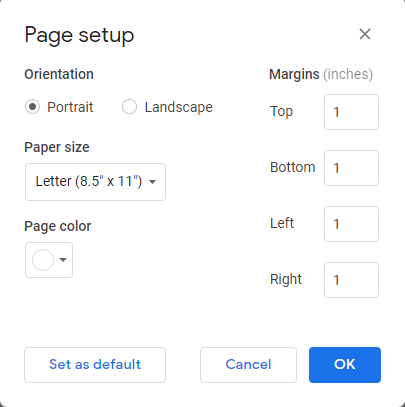Google Docs has many features that can be used to create professional-looking documents. Earlier, we changed the line spacing. Now we will adjust the margins and modify indents.
Copying the practice document
If you are beginning this course at this point, you will need to copy the practice document to your Google Drive.
NOTE: If you have been working through the course, your file should be up to date and you will not need to copy the practice document. You may continue at Adjusting the margins.
- To begin copying the practice document in a new browser window,
Right-click Copy practice document, Click Open link in new window
The file begins to open in a new window of the web browser. Before the document will open and can be edited, we need to make a copy of it.
Move to the new browser window.
- To copy the document file, in the browser window,
Click ![]()
A copy of the file is now open and, by default, is saved in your Google Drive. The filename now has the words "Copy of" at the beginning.
Adjusting the margins
Before we begin changing the text alignment, let's confirm that the ruler is visible. By default, the ruler is turned on, and you will see it on the left side of the screen and directly underneath the toolbar.
If the ruler is not visible, you can easily change this.
- To turn on the ruler, if necessary, on the menu bar,
Click View, Click Show ruler
To adjust the margins, we can use the Page setup dialog box or the ruler.
The Page setup dialog box allows the adjustment of the margins, paper size, paper source, and the layout of the document. Adjustments can be applied to specific parts of a document by highlighting sections of text before opening the Page Setup dialog box.
The Page setup options are located in the File menu.
- To open the Page setup dialog box, on the menu bar,
Click File, Click Page setup
The Page setup dialog box opens:

Using this dialog box, we could adjust the orientation, paper size, page color, and margins of our document. Let's change the left and right margins.
- To adjust the left margin, in the Left field
Double-click the value, type: .5 Tab
- To adjust the right margin, type:
.5 Enter
The margins are both much closer to the edge of the document and the text spans more of the page. This isn't the look we want. Let's change the margins back to 1 inch. This time, let's use the ruler. By pressing and dragging the margin area on the ruler, we can adjust the margins very specifically.
When we hover our mouse over the grey area indicating the margin, we see a tool-tip that tells us this is the left margin as well as a double-sided arrow that indicates the margin can be moved:
![]()
- To adjust the left margin, on the ruler,
Press & drag the left margin to the 1.00 inch mark
The ruler looks like this:

- To adjust the right margin, on the ruler,
Press & drag the right margin to the 6.50 inch mark
The ruler looks like this:

The margins have been returned to the original 1 inch on each side.
Adjusting Paragraph Indents
When working in Google Docs, we can use the tab key to indent the first line of a paragraph. However, using an indent will move the entire left side of a selected section of text to the right. Either a tab or an indent will alter the appearance of the ruler.
Let's use Google Doc’s Increase Indent button to indent the first paragraph. The Increase Indent button will indent the selected paragraph in .5 inch increments.
- To move to the first paragraph, if necessary,
scroll to the top of the document
- To place the cursor in the first paragraph,
Click in the first paragraph
- To indent the first paragraph, on the toolbar,
Click
 three times
three times
The paragraph is indented one and a half inches. The Left Indent marker on the ruler has moved as well.

NOTE: The Left Indent marker is the arrow. The small rectangle represents the First Line Indent.
Let's use the Left Indent marker to move the text back to the margin,
- To return the text to the margin, in the ruler,
Press & Drag the Left Indent marker to 0.0
Adding a hanging indent
Another form of indent is the hanging indent, in which every line after the first line is indented. This type of indent is often used for bibliographic citations.
Let's add hanging indents to our project sources at the end of our document. We will need to move our cursor there before adding the indent.
- To move to the Sources section,
Scroll towards the end of the document
- To move the cursor to the first source,
Click in the first source
- To open the Indentation options dialog box, on the menu bar,
Click Format, Point to Align & indent, Click Indentation options
The Indentation options dialog box opens:

This dialog box gives the option to adjust the Left and Right indents as well as set a Special indent. The hanging indent is considered a Special indent.
- To set a hanging indent, under Special indent,
Click
 , Click Hanging
, Click HangingBy default, the indent is .5 inch. This is what we want.
- To apply the .5 inch Hanging indent,
Click

The first source is now correctly formatted. We could follow the above steps to format each source individually. Instead, let's select the remaining sources and apply the Hanging indent to them all at the same time.
- To select the remaining sources,
Press & drag the remaining sources
- To open the Indentation options dialog box, on the menu bar,
Click Format, Point to Align & indent, Click Indentation options
- To set a hanging indent, under Special indent,
Click
 , Click Hanging
, Click Hanging - To apply the .5 inch Hanging indent,
Click

- To deselect the text,
Click in a blank area of the document
The sources are now indented correctly and may span two pages:


